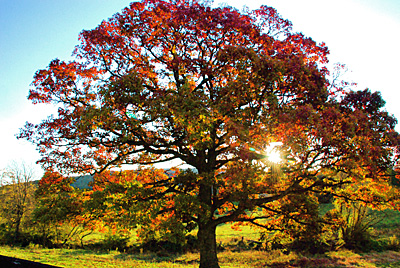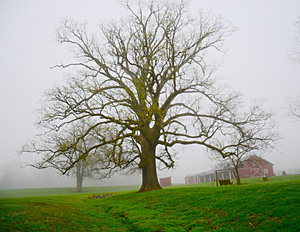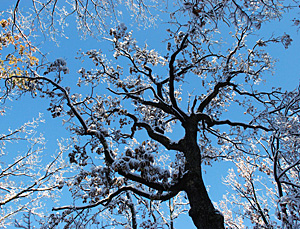Volume 24 Issue 4, Fall 2019
by Carol Ivory
White oaks can be massive and hundreds of years old, but it is not only their size, or even their potential longevity, that makes us consider them the mightiest of trees. These iconic summer shade trees are true life savers, rising from deep roots to provide food and shelter for many species of wildlife.

Sunlight filters through the branches of a White Oak (Quercus alba) tree near Woodgrove Road. Photo by Sharon Plummer
There are between 400 and 600 species of oak trees worldwide, from cool temperate to tropical latitudes in the Americas, Europe, Asia, and North Africa. The U.S. has approximately 90 species, which are generally divided into two categories: red oaks and white oaks. (There is a third category, but those trees are limited to California.)
All white oak leaves have rounded lobes (no bristles), and the acorns mature in the first growing season, drop and sprout in the fall. All red oaks have leaves with bristles on each pointed lobe or at the tip of the leaf. The acorns of red oaks usually mature in the second growing season and sprout the following spring.
All oak trees bear acorns, an important food source for wildlife and an important food source for early civilizations from the poorer classes in ancient Greece to native American tribes. Acorns are enjoying a revival as a human food source. A quick internet search reveals numerous sites dedicated to the benefits of eating acorns and how to prepare them. Another common oak trait — all oak trees have buds clustered at the twig tips. The acorns and the twig buds are both dependable identifiers of oaks.
Oaks are also divided by whether they are deciduous, losing their leaves in the fall, or evergreen. The common term “live oak” is given to any evergreen oak. This is not a scientific designation; evergreen oaks are not more closely related to one another than they are to other oaks, and occur throughout the world. Despite its Latin name, the Southern Live Oak (Quercus virginiana) can in fact only be found in the southeast
corner of the state, and not in Northern Virginia.
Several varieties of white oak loom large in Loudoun landscapes. But this article will focus on the four most commonly found in the county: White Oak, Swamp White Oak, Chestnut Oak, and Post Oak.
White Oak
The White Oak (Quercus alba), which many regard as simply the “finest tree,” gets its name from its pale-gray bark and the pale underside of its leaf. It is the most recognized and iconic of the oaks in Virginia due to its size and shape. It is also the most abundant oak in Virginia. Field-grown White Oaks, which get ample sunlight and no competition, are often 100 feet tall and 100 feet wide. Massive lower branches reach out 50 feet or more and often dip to touch the ground. Trunks often measure five feet or more in diameter. White Oaks can live from 300 to 600 years, and old White Oaks often play an important part in an area’s history and lore.
White Oak acorns have a lower level of tannin and a higher level of sugar than red oaks, making them very tasty to wildlife and probably to humans as well. Wood from the White Oak is used for furniture and flooring. Highly watertight, it was prized for shipbuilding and is still valued for making barrels for whiskey and wine.
If you have a huge White Oak near you, don’t worry — they seldom fall over. When they die, they usually die standing and then come down one branch at a time.
Swamp White Oak

This 2017 Virginia State Champion Swamp White Oak (Quercus bicolor) at Forever Farm in Loudoun is at least 377 years old. Photo by Sharon Plummer
While the majority of oak species prefer upland, well-drained sites, the Swamp White Oak (Quercus bicolor) prefers lowlands, flood plains and stream banks. Its leaves are shallowly lobed, dark green on top and silvery white on the underside, hence its specific epithet “bicolor.” Another reliable identifier are the long stalks on the acorns — up to four inches long! The Swamp White Oak is closely related to the White Oak and shares many of its traits. Its wood is also used for furniture, flooring, and barrels. Swamp White Oaks inhabit the same areas as Pin Oaks, which are also flood-tolerant, but while Pin Oaks have a normal life span of about 100 years, Swamp White Oaks can live to be 300 years old.
There are some beautiful, mature Swamp White Oaks at the Hatcher Avenue trailhead to the Chapman DeMary Trail in Purcellville. This is along the south fork of the Catoctin Creek and is truly a flood plain when the creek overflows its banks and becomes a roaring torrent through the park. The trees are the very large ones at the bottom of the stairs. The Town of Purcellville has planted additional Swamp White Oaks in the picnic area, and it will be gratifying to watch them grow.
Chestnut Oak

Many Chestnut Oaks (Quercus montana) and other oak trees play a towering role in the rich forest landscape at JK Black Oak Wildlife Sanctuary near Lucketts. Photo by Sharon Plummer
The Chestnut Oak (Quercus montana), the second most abundant oak in Virginia, is associated with mountains and Piedmont ridgetops, hence the specific epithet “montana.” Also known as Rock Oak, this tree survives well in dry, rocky soil and often seems to grow right out of rocks, thanks to a well-developed tap root. Its common name stems from the leaves that resemble American Chestnut leaves with rounded lobes. It is very adaptable and can be found in many areas other than ridgetops, frequently growing in naturalized areas throughout northern Virginia suburbs. The bark is a dark gray brown, deeply and coarsely furrowed, differentiating it from other oaks. In poor, rocky soil these oaks are often stunted, but in deeper, richer soils they can reach almost 100 feet in height with an 80-foot spread. Chestnut Oak acorns are relatively large, up to 1½ inches long, and sweet; they are relished by squirrels, deer, and bear.
In Loudoun County large stands of Chestnut Oak can be found along the ridge beginning at Furnace Mountain and extending south toward Leesburg Pike, at Balls Bluff, and other locations throughout the county.
Post Oak
The Post Oak (Quercus stellata) is a slow-growing, long-lived, fire-resistant, smaller tree, 40 to 50 feet tall. The wood is rot-resistant, making it a favorite for fence posts. As with all oaks, its acorns provide food for wildlife. What makes this tree notable and a personal favorite is its unique leaf. They are stiff and leathery with a cross-like shape. Leaves have three lobe pairs with the middle pair wider, giving the appearance of a Maltese cross. There is a very nice Post Oak growing in the field next to the trail to the Balls Bluff cemetery. Once you see the leaves you will be able to easily identify other Post Oaks.
It’s very rewarding to be able to identify trees naturally growing in the area. Look closely at these native white oaks — leaves, bark, and fruit — and add them to your repertoire of familiar trees.
Carol Ivory is a Loudoun County Extension Master Gardener and Tree Steward.

